Wood Duck
- February 16, 2024
- 0 comment
The Wood Duck, also known as Aix sponsa, is a strikingly beautiful waterfowl species native to North America. Renowned for its vibrant plumage, the Wood Duck captivates with its iridescent greens, purples, and blues, creating a spectacle amidst the tranquil wetlands it calls home. These ducks are typically found in wooded swamps, marshes, and freshwater ponds across the continent, seeking refuge among lush vegetation and calm waters. Unique among waterfowl, Wood Ducks exhibit a penchant for nesting in tree cavities or artificial nest boxes, providing elevated sanctuaries for their eggs and young away from ground predators.
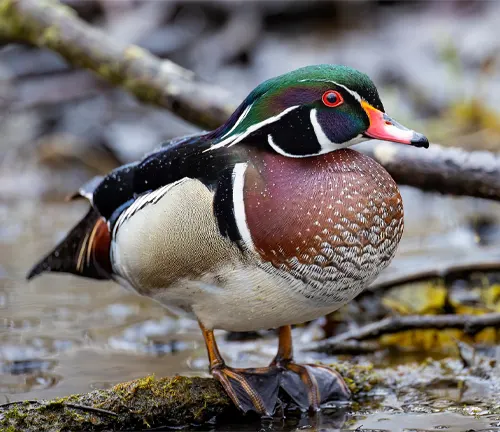
Their breeding season is marked by elaborate courtship displays, showcasing the male’s dazzling colors and vocal prowess to attract mates. Despite facing habitat loss and hunting pressures in the past, conservation efforts have helped stabilize Wood Duck populations, ensuring their continued presence in North America’s wetland ecosystems. Beyond their aesthetic appeal, Wood Ducks play a vital role in their habitats, contributing to seed dispersal and insect population control. As symbols of natural beauty and ecological resilience, Wood Ducks serve as ambassadors for the conservation of wetland ecosystems and the diverse wildlife they support.
| Aspect | Specification |
|---|---|
| Scientific Name | Aix sponsa |
| Common Name | Wood Duck |
| Appearance | Male: Vibrant plumage with iridescent colors |
| Female: Subdued brown hues with white eye-ring | |
| Habitat | Wooded swamps, marshes, freshwater ponds |
| Distribution | North America |
| Nesting Behavior | Utilizes tree cavities or nest boxes for nesting |
| Breeding Season | Spring |
| Courtship Display | Elaborate displays by males to attract mates |
| Diet | Omnivorous, feeds on aquatic plants, seeds, insects |
| Conservation Status | Least Concern (IUCN) |
| Conservation Efforts | Habitat preservation, installation of nest boxes |
| Ecological Role | Seed dispersal, insect population control |
| Importance to Ecosystem | Maintains wetland biodiversity, supports ecosystem health |
Physical Characteristics
In the enchanting realm of North American wetlands, one creature stands out like a vibrant gem amidst the greenery—the Wood Duck. Renowned for its resplendent plumage, the Wood Duck, or Aix sponsa, captivates all who behold it. The males boast an illustrious array of colors, from shimmering greens to iridescent purples, adorned with intricate patterns that seem painted by an artist’s delicate hand. Meanwhile, the females, with their more subdued brown hues and elegant white eye-rings, exude understated beauty. It’s in these details that the Wood Duck truly earns its moniker as one of the continent’s most visually stunning waterfowl.
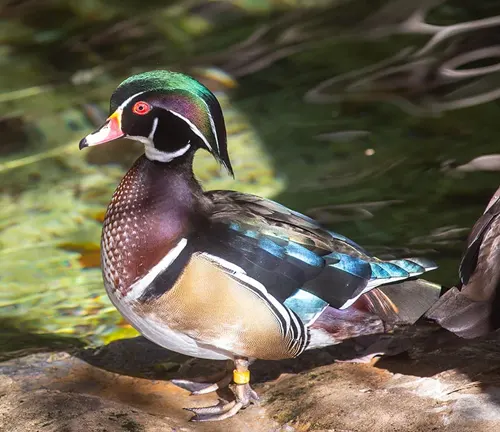
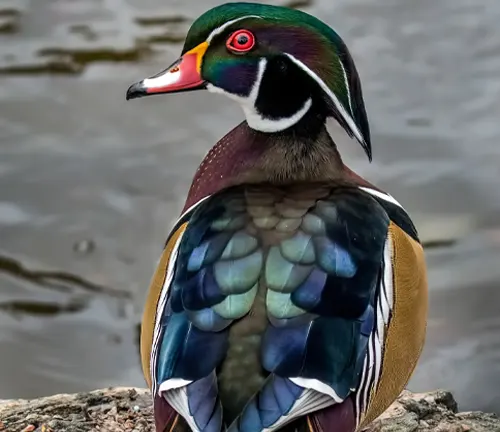
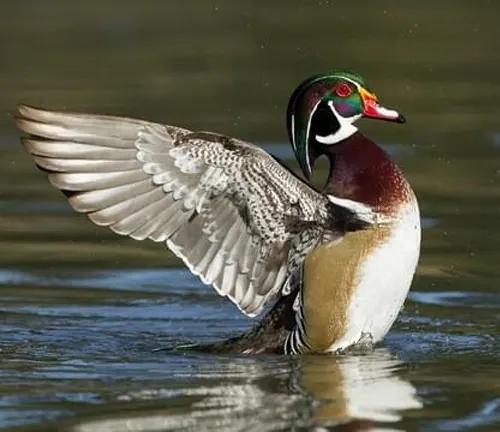
- Vibrant Plumage: The male Wood Duck boasts an array of dazzling colors, including iridescent greens, purples, and blues. These vibrant hues adorn its body, creating a spectacle that captivates observers.
- Intricate Patterns: In addition to its striking colors, the male Wood Duck exhibits intricate patterns on its plumage, adding further depth to its visual appeal. These patterns contribute to its overall elegance and beauty.
- Distinctive White Eye-Ring: Female Wood Ducks have a more subdued appearance compared to males. They typically feature brownish tones on their plumage and are characterized by a distinctive white eye-ring around their eyes, which adds a touch of contrast to their appearance.
- Crested Head: Both male and female Wood Ducks have a small crest atop their heads, adding to their regal appearance. This crest may be more prominent in males during the breeding season, serving as a visual cue during courtship displays.
- Compact Body: Wood Ducks have a compact body with a streamlined shape, which allows them to navigate through dense vegetation in their wetland habitats with ease. This body structure is well-suited for their lifestyle as dabbling ducks, feeding on aquatic plants and foraging along the water’s edge.
Habitat and Distribution
While the Wood Duck’s appearance may steal the spotlight, its habitat preferences and distribution are equally fascinating. These feathered wonders are denizens of wooded wetlands, marshes, and freshwater ponds throughout North America. From the cypress swamps of the southern United States to the boreal forests of Canada, Wood Ducks find sanctuary in habitats rich in vegetation and water, where they can forage for sustenance and seek refuge from predators. Their adaptability to various wetland environments has enabled them to thrive across a wide range of geographical regions.
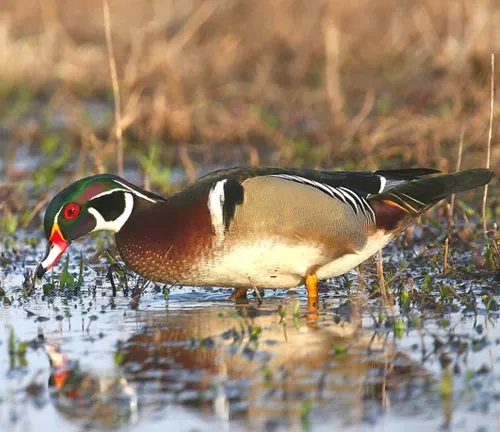

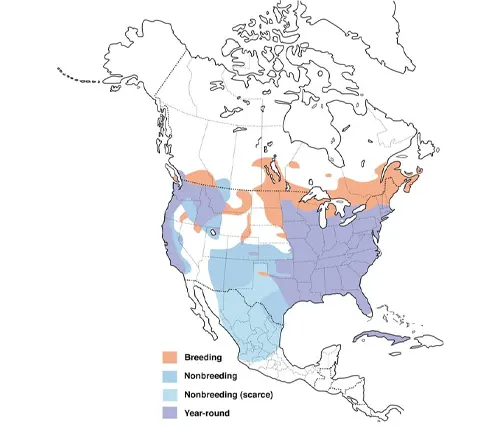
- Wooded Wetlands: Wood Ducks are often associated with wooded wetlands, where they find suitable nesting sites in tree cavities or nest boxes. These habitats provide the necessary cover and protection for breeding pairs and their offspring.
- Marshes and Swamps: In addition to wooded areas, Wood Ducks also inhabit marshes and swamps, especially those with dense vegetation and shallow water. These habitats offer ample foraging opportunities and nesting sites, contributing to the species’ abundance in wetland ecosystems.
- Freshwater Ponds: Wood Ducks are commonly found in freshwater ponds, lakes, and slow-moving streams throughout their range. These water bodies provide essential resources for feeding, bathing, and resting, making them ideal habitats for Wood Ducks.
- North American Range: The Wood Duck’s distribution spans across North America, from the eastern United States and southeastern Canada to parts of Mexico and Central America. While they are more prevalent in the eastern and southern regions of the continent, Wood Ducks can also be found in localized populations in western North America.
- Habitat Fragmentation: Habitat loss and fragmentation due to urbanization, agriculture, and other human activities have impacted Wood Duck populations in some areas. Conservation efforts, such as wetland restoration and habitat preservation, are essential for maintaining suitable habitats for Wood Ducks and other wetland-dependent species.
Behavior and Mating
Beyond their captivating appearance and preferred habitats, the Wood Duck’s behavior and mating rituals offer a glimpse into their intricate lives. Unlike many waterfowl species, Wood Ducks exhibit a unique nesting behavior, often selecting tree cavities or artificial nest boxes for their reproductive endeavors. This preference for elevated nesting sites provides protection for their vulnerable eggs and hatchlings from ground-dwelling predators. During the breeding season, males engage in elaborate courtship displays, showcasing their colorful plumage and vocalizing to attract potential mates. Once paired, the female assumes the task of incubating the eggs while the male stands guard, ensuring the safety of their brood.
Nesting Behavior
Wood Ducks exhibit a distinctive nesting behavior compared to many other duck species. Instead of nesting directly on the ground, they often seek out tree cavities or artificial nest boxes for breeding purposes. This behavior provides protection for their eggs and young from ground-dwelling predators, such as raccoons and foxes.
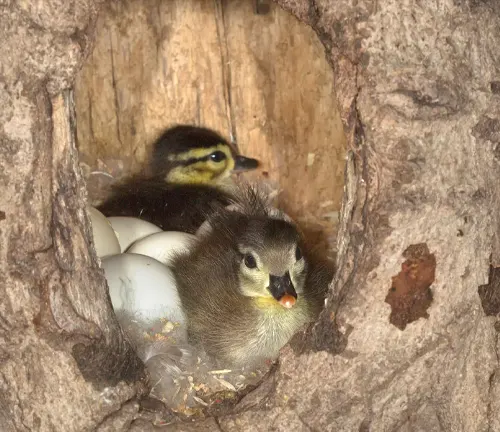
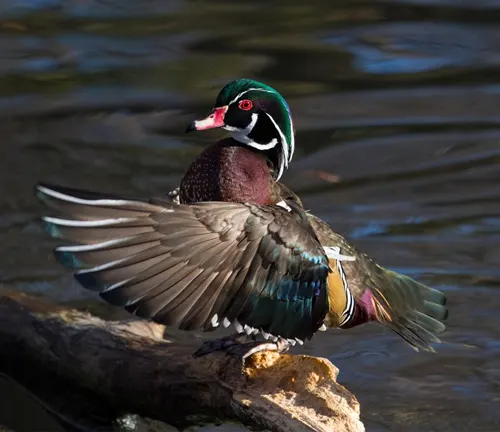
Courtship Displays
During the breeding season, male Wood Ducks engage in elaborate courtship displays to attract potential mates. These displays often involve a combination of visual and vocal signals, including head bobbing, wing flapping, and whistling calls. Males may also swim in tight circles around females or perform aerial displays to showcase their vibrant plumage and fitness as potential partners.
Pair Bonding
Once a pair bond is established, male and female Wood Ducks work together to select a suitable nesting site and prepare the nest. Males may accompany females to potential nesting sites, where they inspect and defend the area against rival males. This cooperative behavior ensures the success of the breeding pair and the survival of their offspring.

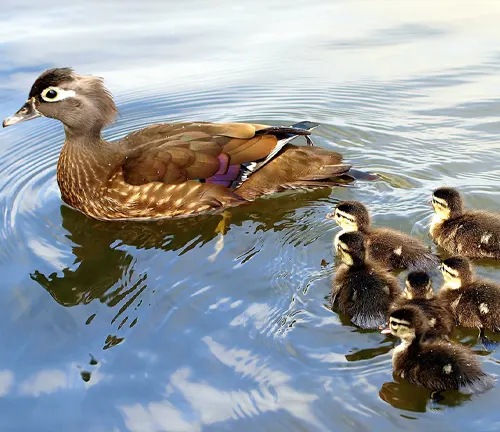
Incubation and Brood Rearing
After the female lays a clutch of eggs, she assumes the primary responsibility for incubating them while the male stands guard nearby. Incubation typically lasts for around 28 days, during which time the female rarely leaves the nest. Once the eggs hatch, both parents take turns caring for the ducklings, leading them to water and teaching them essential survival skills, such as foraging and avoiding predators.
Social Behavior
Outside of the breeding season, Wood Ducks are often observed in small flocks or family groups, foraging together in wetland habitats. They may also form loose associations with other waterfowl species, such as mallards and teal, sharing feeding areas and roosting sites.

Conservation Status
Despite their resilience and adaptability, Wood Ducks have faced challenges due to habitat loss, pollution, and hunting pressures in the past. However, concerted conservation efforts have helped mitigate these threats and stabilize their populations. Initiatives such as wetland restoration, habitat preservation, and the installation of nest boxes have proven instrumental in supporting Wood Duck populations across their range. While their conservation status remains of least concern, continued vigilance and stewardship are essential to safeguarding their future.
- Historical Declines: In the past, Wood Duck populations experienced declines due to habitat loss, wetland degradation, and overhunting. These factors led to localized extinctions in some areas and raised concerns about the long-term viability of the species.
- Conservation Efforts: Over the years, concerted conservation efforts have been implemented to address the threats facing Wood Ducks and their habitats. These efforts have included wetland restoration projects, habitat protection initiatives, and the installation of nest boxes to provide additional breeding sites for the ducks.
- Population Recovery: As a result of these conservation measures, Wood Duck populations have rebounded in many regions across North America. Habitat management practices, such as the creation of wetland reserves and the establishment of protected areas, have helped restore and maintain suitable habitats for the species.
- Hunting Regulations: Hunting regulations and bag limits have been implemented to regulate the harvest of Wood Ducks and ensure sustainable populations. These regulations help prevent overexploitation of the species and promote responsible hunting practices among waterfowl enthusiasts.
- Continued Monitoring: Despite the stable population status of Wood Ducks, ongoing monitoring and research are essential for assessing population trends, identifying emerging threats, and adapting conservation strategies accordingly. Citizen science initiatives, such as bird surveys and nest monitoring programs, play a crucial role in gathering data on Wood Duck populations and their habitats.
Significance to Ecosystem
Beyond their aesthetic allure, Wood Ducks play a vital role in the ecosystems they inhabit. As omnivores, they contribute to seed dispersal by consuming a variety of plant matter and help regulate insect populations by feasting on aquatic invertebrates. Additionally, their presence in wetland habitats provides ecological benefits, such as nutrient cycling and habitat maintenance, that support the overall health and biodiversity of these vital ecosystems. Thus, the Wood Duck serves as both a symbol of natural beauty and a linchpin in the delicate balance of wetland ecosystems.
Different Species
Mandarin Duck
(Aix galericulata)
The Mandarin Duck is native to East Asia and is renowned for its stunningly colorful plumage, similar to that of the Wood Duck. It is often admired for its beauty and is sometimes kept in captivity in various parts of the world.
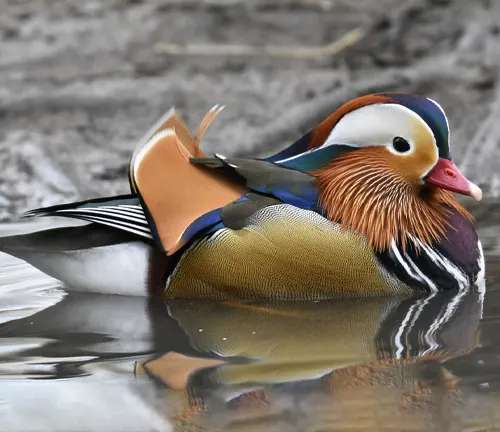
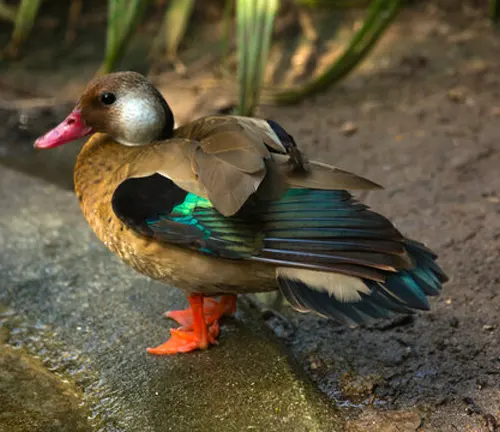
Brazilian Teal
(Amazonetta brasiliensis)
While not closely related to the Wood Duck, the Brazilian Teal shares similar habitat preferences, often inhabiting wooded wetlands and marshes in South America. It is a small dabbling duck with a distinctively patterned plumage.
African Pygmy Goose
(Nettapus auritus)
Another species sometimes colloquially referred to as a “wood duck,” the African Pygmy Goose is native to sub-Saharan Africa. It shares some visual similarities with the Wood Duck, particularly in its striking facial markings and colorful plumage.
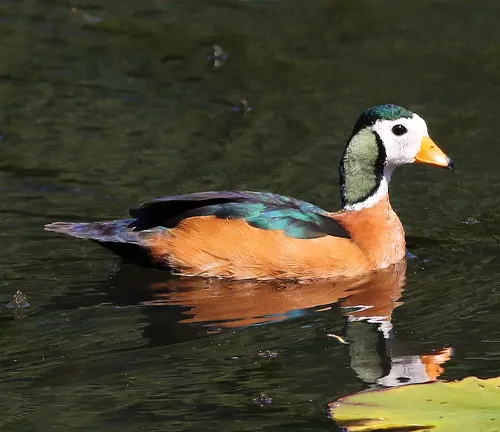
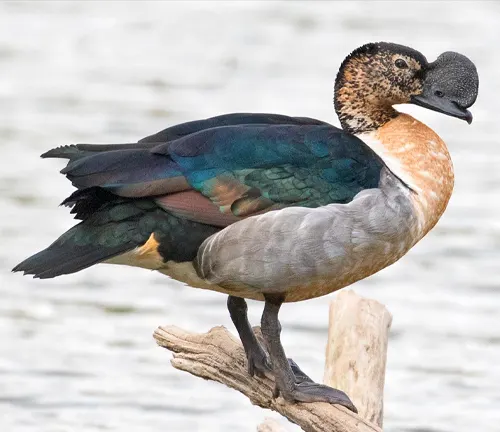
Comb Duck
(Sarkidiornis melanotos)
The Comb Duck, native to Africa, Asia, and parts of South America, is another duck species that occasionally bears the moniker “wood duck.” It is known for its unique appearance, characterized by a large, fleshy “comb” atop its bill during the breeding season.
Frequently Asked Question (FAQs)
1. What is a Wood Duck?
The Wood Duck, scientifically known as Aix sponsa, is a species of colorful waterfowl native to North America. It is renowned for its striking appearance, featuring vibrant plumage and distinctive markings.
2. Where do Wood Ducks live?
Wood Ducks are typically found in wooded swamps, marshes, and ponds throughout their range in North America. They prefer habitats with abundant vegetation and calm water.
3. What do Wood Ducks eat?
Wood Ducks are omnivorous, feeding on a variety of aquatic plants, seeds, insects, and small invertebrates. They are also known to forage on land near water bodies.
4. How do Wood Ducks reproduce?
Wood Ducks exhibit unique nesting behavior, often utilizing tree cavities or nest boxes rather than nesting directly on the ground like many other duck species. They engage in elaborate courtship displays during the breeding season, and females typically incubate the eggs while males stand guard.
5. Are Wood Ducks endangered?
Wood Ducks are not considered endangered. However, they have faced challenges in the past due to habitat loss and hunting pressures. Conservation efforts, such as habitat preservation and the installation of nest boxes, have helped stabilize their populations.
6. What is the difference between male and female Wood Ducks?
Male Wood Ducks have vibrant plumage with iridescent colors, including shades of green, purple, and blue, along with intricate patterns. Female Wood Ducks have more subdued brown hues and a distinctive white eye-ring.
7. What is the conservation status of Wood Ducks?
Wood Ducks are classified as a species of “Least Concern” by the International Union for Conservation of Nature (IUCN). While their populations have faced challenges, conservation efforts have helped in stabilizing their numbers.
8. What role do Wood Ducks play in their ecosystems?
Wood Ducks play a vital ecological role in their ecosystems by dispersing seeds, controlling insect populations, and contributing to the overall health of wetland habitats.
9. Can Wood Ducks be kept as pets?
In many places, it is illegal to keep Wood Ducks as pets without proper permits. Additionally, wild animals are best left in their natural habitats to maintain their well-being and the balance of ecosystems.
10. How can I help conserve Wood Ducks?
Individuals can contribute to Wood Duck conservation efforts by supporting habitat preservation initiatives, participating in citizen science projects, and advocating for policies that protect wetland habitats and wildlife.


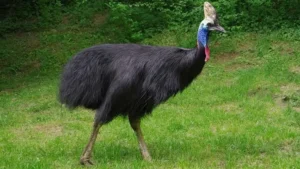
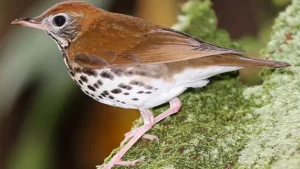
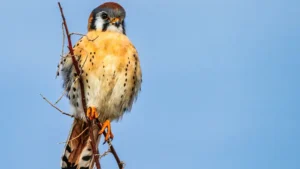
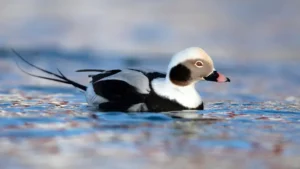
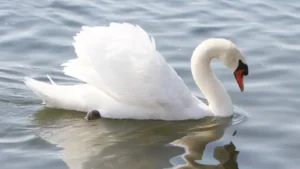
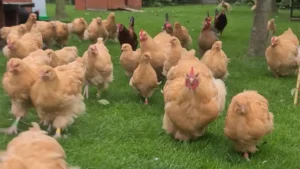
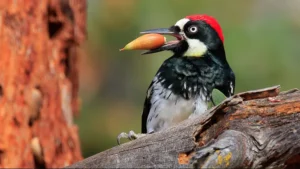
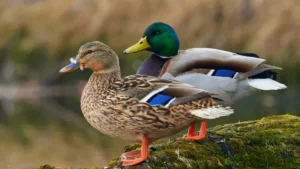
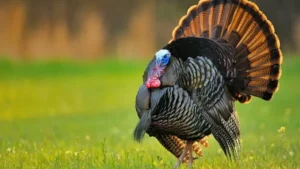

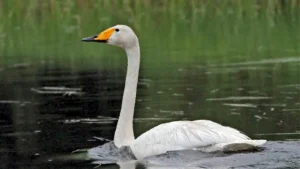
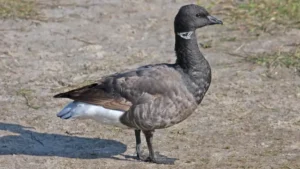
Leave your comment